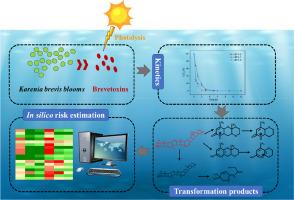Deciphering the photodegradation fate of Brevetoxins: Kinetics, degradation pathways, and toxicity evaluation
IF 4.5
1区 生物学
Q1 MARINE & FRESHWATER BIOLOGY
引用次数: 0
Abstract
Karenia brevis blooms have emerged as an increasing global concern due to their capacity to produce brevetoxins (BTXs), which are potent marine neurotoxins. The ecological impact of BTXs is significantly modulated by the natural attenuation process, with photodegradation playing a pivotal role. Nevertheless, the fate of BTXs following photodegradation remains inadequately understood. This study elucidates the photodegradation kinetics of three representative BTXs and identifies their transformation products (TPs). The observed first-order photodegradation rate coefficient, based on the logarithmic transformation of dissolved BTXs concentrations against irradiation time, ranged from 0.84 to 2.49 h-1. Utilizing high-resolution liquid chromatography‒mass spectrometry, three, four, and five TPs were identified for BTX-1, BTX-2, and BTX-3, respectively. All TPs underwent substantial structural modifications with significant mass reductions. Proposed primary photodegradation pathways encompass Ring-opening, alkyl chain cleavage, hydrolysis, dehydroxylation, epoxidation, and β-elimination. Additionally, in silico prediction indicated that the biodegradability of TPs was significantly higher than that of the parent toxins. However, certain TPs exhibited greater toxicities compared to their parent toxins. The coexistence of multiple BTXs and TPs may lead to synergistic toxicity, thereby posing secondary risks to aquatic organisms. Overall, this research will enhance a comprehensive understanding of the environmental behaviors and risks associated with BTXs.

解读短叶毒素的光降解命运:动力学、降解途径和毒性评价
由于短克雷氏菌能够产生短毒素(BTXs),这是一种强效的海洋神经毒素,短克雷氏菌的大量繁殖已成为全球日益关注的问题。BTXs的生态影响受自然衰减过程的显著调节,其中光降解起关键作用。然而,BTXs在光降解后的命运仍然没有得到充分的了解。本研究阐明了三种代表性BTXs的光降解动力学,并鉴定了它们的转化产物(TPs)。基于溶解BTXs浓度随辐照时间的对数变换,观察到的一级光降解率系数范围为0.84 ~ 2.49 h-1。利用高分辨率液相色谱-质谱联用技术,分别鉴定出BTX-1、BTX-2和BTX-3的3种、4种和5种TPs。所有TPs都进行了大量的结构修改,质量显著降低。提出的主要光降解途径包括开环、烷基链裂解、水解、去羟基化、环氧化和β消除。此外,计算机预测表明,TPs的生物降解性显著高于母体毒素。然而,与母体毒素相比,某些TPs表现出更大的毒性。多种BTXs和TPs共存可能导致协同毒性,从而对水生生物构成二次风险。总体而言,本研究将增强对与BTXs相关的环境行为和风险的全面理解。
本文章由计算机程序翻译,如有差异,请以英文原文为准。
求助全文
约1分钟内获得全文
求助全文
来源期刊

Harmful Algae
生物-海洋与淡水生物学
CiteScore
12.50
自引率
15.20%
发文量
122
审稿时长
7.5 months
期刊介绍:
This journal provides a forum to promote knowledge of harmful microalgae and macroalgae, including cyanobacteria, as well as monitoring, management and control of these organisms.
 求助内容:
求助内容: 应助结果提醒方式:
应助结果提醒方式:


